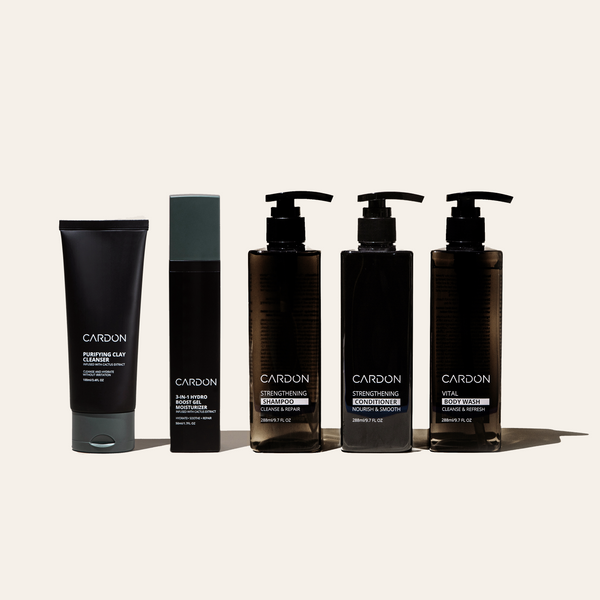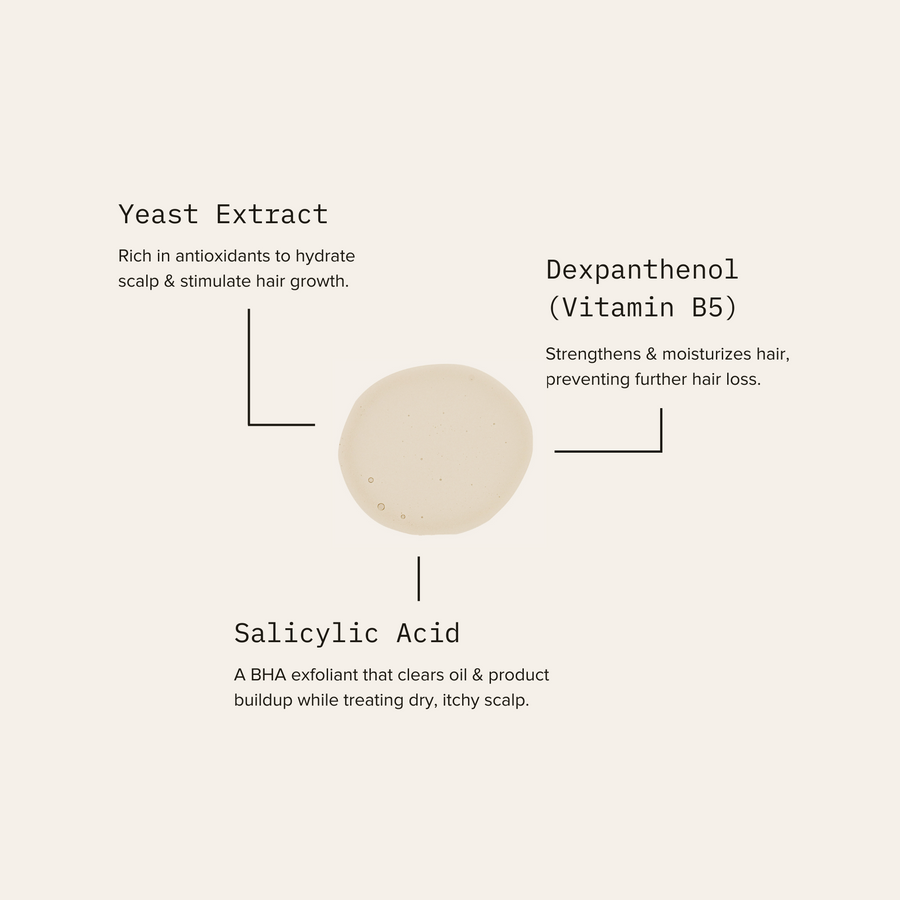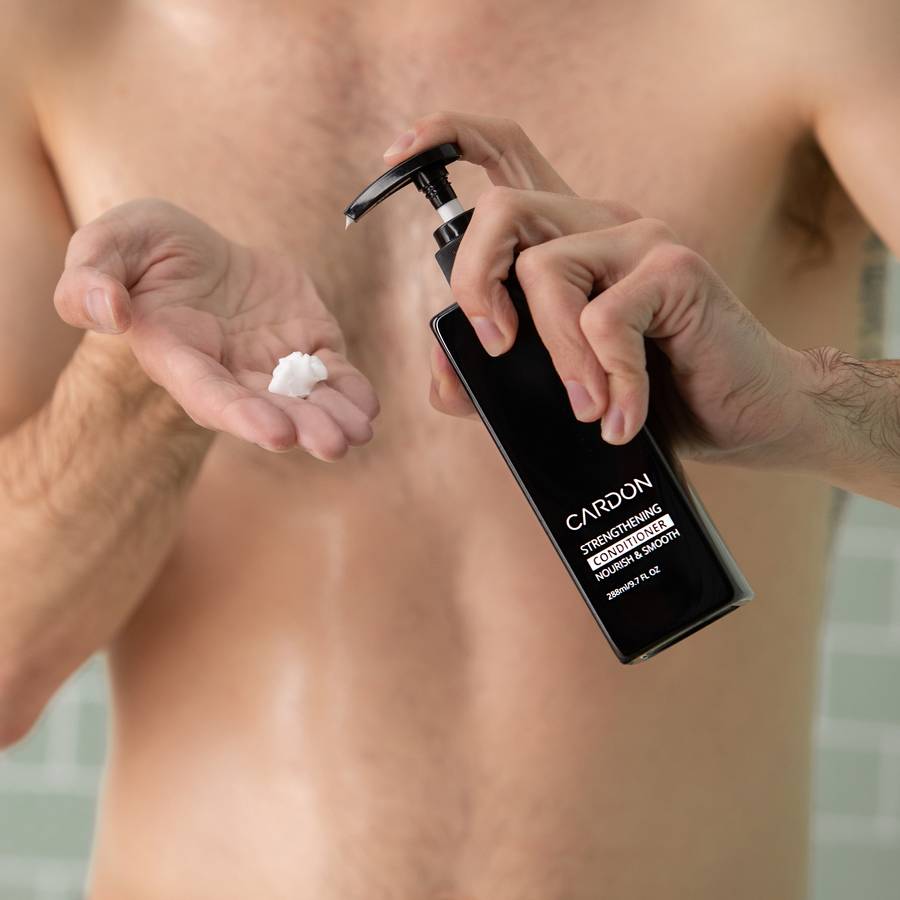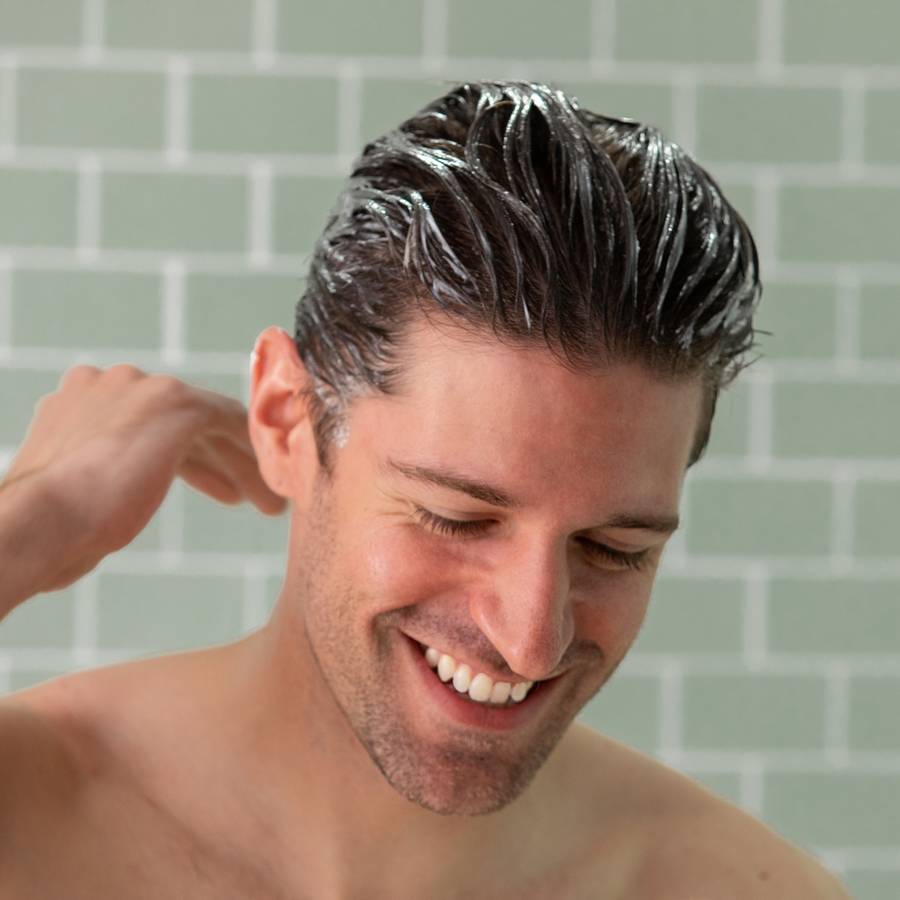How Yeast Extract Can Promote Better Hair Growth
Having a healthy, hydrated scalp is imperative if you want stronger, fuller hair. And yeast extract—yes, like in beer!—is one ingredient that can help.

Here’s one way to convince yourself that drinking beer is good for you: The yeast in beer has many nutritional benefits, namely a bunch of B vitamins and proteins. (So the next time you see someone with a beer belly, just remind yourself that he’s well nourished!) And turns out, if you apply yeast extract to your scalp, it has numerous benefits for your hair’s strength and longevity—that is, when it’s an ingredient in shampoo or conditioner, as opposed to pouring out a beer on your head. Spare the beer please, or better yet, crack it open in the shower to get double the nourishment.
Yeast Extract Scalp Benefits
Yeast extract is extremely beneficial for the wellness of your scalp and for hair growth, thanks to its richness in B Vitamins, proteins, fatty acids, magnesium zinc, flavonoids, and more. Here are the primary reasons the ingredient is good to have in a shampoo and/or conditioner.

- It is rich in antioxidants. Yeast extract can fortify the scalp to counter everyday environmental stressors (toxins) like pollution and UV rays, in addition to any biological stress that you experience. By arming your scalp (and hair) with antioxidants, yeast extract then promotes all of the following benefits by protecting the integrity of each cell and their respective functions. In short, antioxidants in yeast extract prevent cellular deterioration.
- It is hydrating. Yeast extract is naturally moisturizing and, as an extension of its antioxidant benefits, also can prevent cellular dehydration. One job of your skin’s outermost layer is to trap moisture inside the deeper layers; by fortifying these cells, you further improve the skin’s ability to retain the moisture it already has.
- It has cellular renewal properties. Yeast extract can accelerate cellular turnover. So, when it is pumped into your hair follicles, it can promote faster growth (likely due to its Vitamin B properties, one of which is vitamin B7, or biotin). It can also stimulate the production of collagen and elastin in skin cells, which can keep skin firm and keep follicles anchored.
- It is anti-inflammatory. Yeast extract can soothe skin and reduce inflammation across the scalp, helping to create a calm, balanced environment for the hair to grow unencumbered.
How to Incorporate Yeast Extract Into Your Hair Care Routine
When you use any shampoo or conditioner, one important thing to remember is that you don’t get all of the benefits of these products if you quickly rinse them away. Otherwise, you may as well wash your hair with hand soap if all you want is an easy clean.

In order to absorb benefits like yeast extract in a hair-boosting shampoo or conditioner, you should take the following approach with the products:
1. Massage the shampoo all around your head. Not only is this a great excuse to give yourself a quick scalp massage—and one that stimulate circulation and ultimately improves hair retention—but it also fully distributes the shampoo product throughout your scalp. And in massaging it directly into the dome, you ensure that the ingredients are interacting with the skin, where they can then be absorbed. Start with this, and then if you have medium or longer hair, follow with distributing the shampoo throughout all of your strands.
2. Rinse after 30-60 seconds. It is not imperative for you to have shampoo soaking into your strands for too long; one minute should suffice in order to get a thorough rinse while also allowing some delivery of nourishment with the targeted ingredients. But on that note…
3. Make sure your shampoo has moisturizing properties. This ensures that it doesn’t parch your strands. Of course yeast extract itself is nourishing, but be certain your product of choice has a base that thoroughly nourishes the strands and scalp alike, rich in ingredients such as glycerin and dexpanthenol. (Like Cardon’s shampoo.)
4. Follow with a conditioner. This product helps pump nutrients back into the hair, and can seal off the cuticle to prevent further dehydration and things like breakage, frizzing, split ends, and so forth. Even if you keep your hair short, conditioner makes your hair more cooperative when styling, and ensures that it looks healthy as opposed to dry and brittle. Conditioner also hydrates and fortifies the scalp, in turn preventing things like dandruff and inflammation (especially if it is a balancing formula, rich in ingredients like yeast extract). Massage it in just like you did the shampoo, potentially adding splashes of water to help distribute it evenly. Be certain the hair is conditioned from scalp to ends, too. And remember, every time you shampoo, you need to chase it with a conditioner, and never at the same time; that’s because when used together, you render the conditioner less effective.
5. Rinse after 2 minutes. Let the conditioner sit longer in your hair than the shampoo, giving those nutrients ample time to absorb and to coat the strands. This is a good time to do your body cleansing.
6. Shampoo every 2-3 days, condition almost daily (if not daily). You don’t need to wash your hair every day. In fact, it’s probably better for hair and scalp alike if you merely rinse it every other day in between washes, unless you worked up a good sweat and need a refresh. Overwashing can dry out the hair and scalp, no matter the product’s nourishing abilities. Instead, you can rely on conditioner on the non-shampoo days to act as a rinse aid, while simultaneously nourishing strands. But don’t feel compelled to condition every day, either; the most important thing is that you always use conditioner after shampooing. It’s just that you need to limit the shampooing, specifically.
Shop the collection


Hair + Body Shower Set
good for:
New + Improved: Same thickening formula now with biotin! The Hair + Body Shower Set has everything you need for an invigorating showertime routine, going beyond cleansing to strengthen, repair, and soothe your hair and skin. You—and your houseguests—will thank you for ditching the 3-in-1 for this trio.
*Vital Body Wash – winner of the 2022 GQ Grooming Awards
Includes Steps:
- 01 Hair Thickening + Strengthening Shampoo
- 02 Hair Thickening + Strengthening Conditioner
- 03 Vital Body Wash
Never go empty! Subscribe + Save 10%
Hair + Body Shower Set
good for:
New + Improved: Same thickening formula now with biotin! The Hair + Body Shower Set has everything you need for an invigorating showertime routine, going beyond cleansing to strengthen, repair, and soothe your hair and skin. You—and your houseguests—will thank you for ditching the 3-in-1 for this trio.
*Vital Body Wash – winner of the 2022 GQ Grooming Awards
Includes Steps:
- 01 Hair Thickening + Strengthening Shampoo
- 02 Hair Thickening + Strengthening Conditioner
- 03 Vital Body Wash
Never go empty! Subscribe + Save 10%


NEW
NEW
+ Hair
+ Body
Head-to-Toe Set
good for:
We've got you covered head to toe, literally. This set comes with a complete skin and hair care routine.
Includes our invigorating shampoo and conditioner to prevent hair loss, refreshing body wash to treat body acne, clay-infused face wash to deeply cleanse the face from debris, and lightweight gel moisturizer to soothe, rehydrate and repair skin while you sleep.
It's about time you treated the rest of your body as good as you treat your face.
Includes Steps:
- 01 Purifying Clay Cleanser
- 02 Hydro Boost Gel Moisturizer
- 03 Hair Thickening + Strengthening Shampoo
- 04 Hair Thickening + Strengthening Conditioner
- 05 Vital Body Wash
Never go empty! Subscribe + Save 10%
Head-to-Toe Set
good for:
We've got you covered head to toe, literally. This set comes with a complete skin and hair care routine.
Includes our invigorating shampoo and conditioner to prevent hair loss, refreshing body wash to treat body acne, clay-infused face wash to deeply cleanse the face from debris, and lightweight gel moisturizer to soothe, rehydrate and repair skin while you sleep.
It's about time you treated the rest of your body as good as you treat your face.
Includes Steps:
- 01 Purifying Clay Cleanser
- 02 Hydro Boost Gel Moisturizer
- 03 Hair Thickening + Strengthening Shampoo
- 04 Hair Thickening + Strengthening Conditioner
- 05 Vital Body Wash
Never go empty! Subscribe + Save 10%


Hair Loss
Healthy Hair Duo
good for:
New + Improved: Same thickening formula now with biotin! Teamwork makes your hair dreams work.
Our highly-rated Hair Thickening + Strengthening Shampoo and Conditioner teams up to get to the root of hair loss, strengthening and nourishing hair starting right at the scalp. Achieve thicker, healthier follicles with the help of our protein and vitamin-packed formula.
Includes Steps:
- 01 Hair Thickening + Strengthening Shampoo
- 02 Hair Thickening + Strengthening Conditioner
Never go empty! Subscribe + Save 10%
Healthy Hair Duo
good for:
New + Improved: Same thickening formula now with biotin! Teamwork makes your hair dreams work.
Our highly-rated Hair Thickening + Strengthening Shampoo and Conditioner teams up to get to the root of hair loss, strengthening and nourishing hair starting right at the scalp. Achieve thicker, healthier follicles with the help of our protein and vitamin-packed formula.
Includes Steps:
- 01 Hair Thickening + Strengthening Shampoo
- 02 Hair Thickening + Strengthening Conditioner
Never go empty! Subscribe + Save 10%


Hair Thickening + Strengthening Shampoo
good for:
New + Improved: Same thickening formula now with biotin! Stop hair loss—from receding hairlines to thinning hair—with the first step in your shower routine.
Our protein-packed Hair Thickening + Strengthening Shampoo uses niacinamide, vitamin B5, and yeast extract to restore hair follicles while protecting the scalp and reducing flakiness, too. The result? Thicker, stronger hair that’s here to stay.
“A true example of less is more. This shampoo is perfect. Leaves my hair feeling and looking healthy and thick and does not irritate my sensitive skin. A must add to my Cardon skincare regimen.” - David N.
Hair Thickening + Strengthening Shampoo
good for:
New + Improved: Same thickening formula now with biotin! Stop hair loss—from receding hairlines to thinning hair—with the first step in your shower routine.
Our protein-packed Hair Thickening + Strengthening Shampoo uses niacinamide, vitamin B5, and yeast extract to restore hair follicles while protecting the scalp and reducing flakiness, too. The result? Thicker, stronger hair that’s here to stay.
“A true example of less is more. This shampoo is perfect. Leaves my hair feeling and looking healthy and thick and does not irritate my sensitive skin. A must add to my Cardon skincare regimen.” - David N.


Hair Loss
Hair Thickening + Strengthening Conditioner
good for:
New + Improved: Same thickening formula now with biotin! Finally, a conditioner that doesn’t just soothe—but strengthens, too.
Our Strengthening Conditioner uses Niacinamide and Yeast Extract to get to the root of hair loss issues, nourishing the hair starting right at the scalp for stronger hair that’s smooth as silk.
“A perfect compliment to the shampoo. Adds amazing hydration to the hair, leaving it soft (even with hard water)! A nice, but not overpowering, menthol scent.” - Steve C.
Hair Thickening + Strengthening Conditioner
good for:
New + Improved: Same thickening formula now with biotin! Finally, a conditioner that doesn’t just soothe—but strengthens, too.
Our Strengthening Conditioner uses Niacinamide and Yeast Extract to get to the root of hair loss issues, nourishing the hair starting right at the scalp for stronger hair that’s smooth as silk.
“A perfect compliment to the shampoo. Adds amazing hydration to the hair, leaving it soft (even with hard water)! A nice, but not overpowering, menthol scent.” - Steve C.


NEW
NEW
Cleanse + Refresh Set
good for:
Hit refresh! The Cleanse + Refresh Set gives you the ultimate cleanse from head to toe with highly-effective skincare-grade formulas. Strengthening Shampoo boosts hair volume, Vital Body Wash fights dryness and breakouts, and Purifying Clay Cleanser keeps your skin clear and balanced. It's the perfect set for a fresh, confident look every day!
Pro tip: Use Purifying Clay Cleanser as a spot treatment for pimples or pore-clearing clay mask. Apply to the affected area or the full face and rinse off after 10 minutes.
Includes Steps:
- 01 Purifying Clay Cleanser
- 02 Hair Thickening + Strengthening Shampoo
- 03 Vital Body Wash
Never go empty! Subscribe + Save 10%
Cleanse + Refresh Set
good for:
Hit refresh! The Cleanse + Refresh Set gives you the ultimate cleanse from head to toe with highly-effective skincare-grade formulas. Strengthening Shampoo boosts hair volume, Vital Body Wash fights dryness and breakouts, and Purifying Clay Cleanser keeps your skin clear and balanced. It's the perfect set for a fresh, confident look every day!
Pro tip: Use Purifying Clay Cleanser as a spot treatment for pimples or pore-clearing clay mask. Apply to the affected area or the full face and rinse off after 10 minutes.
Includes Steps:
- 01 Purifying Clay Cleanser
- 02 Hair Thickening + Strengthening Shampoo
- 03 Vital Body Wash
Never go empty! Subscribe + Save 10%
Cardon Products Are
Easy to Use
We never create two products when we can achieve the same results with one. Cardon products are designed to be easy to use every day.
Backed By Korean Innovation
Korean R&D is two decades ahead of the rest of the world. Cardon products use the highest quality, most effective ingredients out there.
Non-Toxic
Finally, an ingredient label you can feel good about. Every ingredient in Cardon products is good for your skin, and easy on the mind.






















































